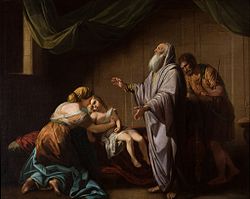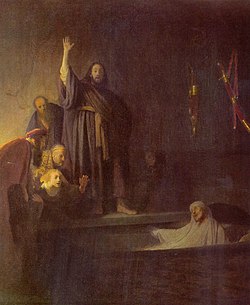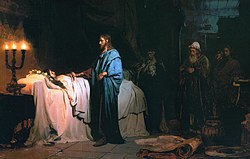Raising of the Dead





The raising of the dead or awakening of the dead (Greek: εγειρω egeiro "to wake up, to raise, to erect"), which is often mistakenly equated with resurrection, is possible under suitable circumstances within a period of about three days after death, provided that the physical body has not been irreparably destroyed and the etheric body has largely but not yet completely detached itself from the physical body and dispersed in the general etheric world. At least by a narrow band, often called the so-called silver cord or similar, the astral body must also still be connected with the physical body. This is also how it is described in a passage of the Old Testament, where it says:
„... because all must go to their eternal home, and the mourners will go about the streets; 6 before the silver cord is snapped, and the golden bowl is broken, and the pitcher is broken at the fountain, and the wheel broken at the cistern, 7 and the dust returns to the earth as it was, and the breath returns to God who gave it.“
Through the raising of the dead, unlike the resurrection, the dead person returns to his original mortal body. So by raising the dead, death is by no means finally defeated.
Awakening reports in the Bible
Old Testament
Three raisings from death are reported in the Old Testament:
- The Raising of the son of the widow of Zarephath by Elijah, which has some parallels with the raising of the son of the widow of Nain:
„17 After this the son of the woman, the mistress of the house, became ill. And his illness was so severe that there was no breath left in him. 18 And she said to Elijah, “What have you against me, O man of God? You have come to me to bring my sin to remembrance and to cause the death of my son!” 19 And he said to her, “Give me your son.” And he took him from her arms and carried him up into the upper chamber where he lodged, and laid him on his own bed. 20 And he cried to the Lord, “O Lord my God, have you brought calamity even upon the widow with whom I sojourn, by killing her son?” 21 Then he stretched himself upon the child three times and cried to the Lord, “O Lord my God, let this child’s life come into him again.” 22 And the Lord listened to the voice of Elijah. And the life of the child came into him again, and he revived. 23 And Elijah took the child and brought him down from the upper chamber into the house and delivered him to his mother. And Elijah said, “See, your son lives.” 24 And the woman said to Elijah, “Now I know that you are a man of God, and that the word of the Lord in your mouth is truth.”“
- The raising of the son of the woman of Shunem by Elisha:
„32 When Elisha came into the house, he saw the child lying dead on his bed. 33 So he went in and shut the door behind the two of them and prayed to the Lord. 34 Then he went up and lay on the child, putting his mouth on his mouth, his eyes on his eyes, and his hands on his hands. And as he stretched himself upon him, the flesh of the child became warm. 35 Then he got up again and walked once back and forth in the house, and went up and stretched himself upon him. The child sneezed seven times, and the child opened his eyes.“
- The death and raising of Elisha:
„20 So Elisha died, and they buried him. Now bands of Moabites used to invade the land in the spring of the year. 21 And as a man was being buried, behold, a marauding band was seen and the man was thrown into the grave of Elisha, and as soon as the man touched the bones of Elisha, he revived and stood on his feet.“
New Testament
Gospels
In the New Testament three awakenings of the dead which the Christ fulfilled are described. With these awakenings at the same time the spirit of the three cultural epochs that preceded the Greco-Latin period is reawakened in a renewed form:
„In the Gospel of Matthew we are told how from the Orient come the three magi who offer their frankincense, their gold and their myrrh to the newborn infant Jesus, the reincarnated Zarathustra. They pay homage to their re-embodied Master who has worked in his various incarnations in the three preceding cultural epochs. They are, as it were, the keepers of the ancient wisdom treasures from the ancient Indian, the ancient Persian and the Egyptian-Babylonian epochs. And by laying these at the feet of the infant Jesus in the symbolic form of incense, gold and myrrh, they point out, as it were, how what has worked as cultural germs in these periods can only be saved for humanity if it is permeated by the Christ-power that will one day animate this infant. They themselves will no longer experience this resurrection of the wisdom treasures of their cultural epochs. "They went back to their country by another way".
But we can ask ourselves the question: Where do these three wise men remain later, what actually becomes of their wisdom? And we must remember that the cultures that arise and pass away here on Earth contain within them a seed that can be fertilised by the Christ Impulse and that will come to flower again in the periods of time that follow the Mystery of Golgotha. What the three magi from the Orient sacrificed as cultural germs to the infant Jesus will be raised up by the Christ; this contains the forces which can really permeate these three later cultural periods with the Christ Impulse. The third post-Atlantean age, in all that it contained as wisdom, will be raised up by the Christ, so that it can fertilise our fifth age. The second age, that of Zarathustra, is being awakened so that in the sixth post-Atlantean age the true understanding of the Christ can be there. And the first, the ancient Indian age, experiences its resurrection in the seventh post-Atlantean age with the help of the Christ-power.
And in each case the Christ must raise up a certain personality, a human soul, which is called by its destiny to be the special bearer of this germ of culture from ancient times, and which is at the same time that soul which can see to it that what the Christ has brought to humanity as gifts is also continued, that the understanding of the Christ and his mission can also be taught to humanity in later times in the appropriate way.“ (Lit.:GA 264, p. 227f)
The following awakenings from death are mentioned in the Gospels:
- The raising of Jairus' daughter, reported in all three Synoptic Gospels: Mark 5:35–43, Matthew 9:23–26 and Luke 8:49–56 (Ancient Indian culture).
- The raising of Lazarus of Bethany, who according to Rudolf Steiner became the favourite disciple of the Christ and is identical with John the Evangelist: John 11:1–45 (Ancient Persian culture).
- The raising of the youth of Nain, the son of the widow, who was later reborn as Mani and then as Parzival: Luke 7:11–17 (Egyptian-Chaldean culture).
Acts of the Apostles
In addition, the Acts of the Apostles report two little-known raisings of the dead, which the Apostles Peter and Paul respectively perform with the help of the Christ.
- The raising of Tabitha by Peter:
„36 Now there was in Joppa a disciple named Tabitha, which, translated, means Dorcas.[1] She was full of good works and acts of charity. 37 In those days she became ill and died, and when they had washed her, they laid her in an upper room. 38 Since Lydda was near Joppa, the disciples, hearing that Peter was there, sent two men to him, urging him, “Please come to us without delay.” 39 So Peter rose and went with them. And when he arrived, they took him to the upper room. All the widows stood beside him weeping and showing tunics and other garments that Dorcas made while she was with them. 40 But Peter put them all outside, and knelt down and prayed; and turning to the body he said, “Tabitha, arise.” And she opened her eyes, and when she saw Peter she sat up. 41 And he gave her his hand and raised her up. Then, calling the saints and widows, he presented her alive.“
- The raising of Eutychus by Paul:
„7 On the first day of the week, when we were gathered together to break bread, Paul talked with them, intending to depart on the next day, and he prolonged his speech until midnight. 8 There were many lamps in the upper room where we were gathered. 9 And a young man named Eutychus, sitting at the window, sank into a deep sleep as Paul talked still longer. And being overcome by sleep, he fell down from the third story and was taken up dead. 10 But Paul went down and bent over him, and taking him in his arms, said, “Do not be alarmed, for his life is in him.”“
Raising from death and initiation
Raising from the sleep of death was systematically cultivated in many pre-Christian schools of initiation, for example in the Egyptian Mysteries. The initiate was put into a death-like state for three days, during which the etheric body and the astral body were lifted as far as possible out of the physical body and remained connected to it only by the thin silver cord mentioned above. In this way, the spiritual experiences that the initiate had in the out-of-body state could be imaged unhindered in the etheric body and the initiate could report on his experiences after his awakening.
The awakenings of the dead by the Christ, which are described in the New Testament, are also to be understood as such initiation ceremonies, which, however, were not systematically brought about within a mystery community, but directly by the fate of the world. This is the case, for example, with the awakening of Lazarus:
„During the initiation, as described in the Gospel of John, the astral body leaves the physical body together with the etheric body. The latter then remains behind as in death. This is the basis for the description that Lazarus lay in the grave for three days. The miracle of Lazarus is therefore the image of an initiation. It is about bringing the astral and etheric body back into the physical body. This is done by the Master. The human being is now an awakened one who can remember the experiences in the higher worlds.“ (Lit.:GA 94, p. 203)
The awakened Lazarus thus became the beloved disciple, who was able to bear witness of his initiatory experiences in the Gospel of John.
Literature
- Rudolf Steiner: Kosmogonie, GA 94 (2001) English: rsarchive.org German: pdf pdf(2) html mobi epub archive.org
- Rudolf Steiner: Zur Geschichte und aus den Inhalten der ersten Abteilung der Esoterischen Schule 1904 bis 1914, GA 264 (1987), ISBN 3-7274-2650-0 English: rsarchive.org German: pdf pdf(2) html mobi epub archive.org
 |
References to the work of Rudolf Steiner follow Rudolf Steiner's Collected Works (CW or GA), Rudolf Steiner Verlag, Dornach/Switzerland, unless otherwise stated.
Email: verlag@steinerverlag.com URL: www.steinerverlag.com. Index to the Complete Works of Rudolf Steiner - Aelzina Books A complete list by Volume Number and a full list of known English translations you may also find at Rudolf Steiner's Collected Works Rudolf Steiner Archive - The largest online collection of Rudolf Steiner's books, lectures and articles in English. Rudolf Steiner Audio - Recorded and Read by Dale Brunsvold steinerbooks.org - Anthroposophic Press Inc. (USA) Rudolf Steiner Handbook - Christian Karl's proven standard work for orientation in Rudolf Steiner's Collected Works for free download as PDF. |
